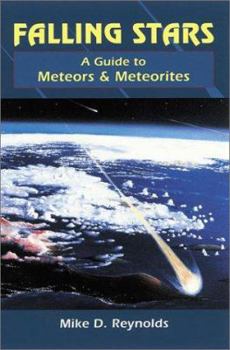Falling Stars: A Guide to Meteors and Meteorites
Select Format
Select Condition 
Book Overview
Month-by-month information on meteor showers and how to make the most of watching themAdvice on starting and building a meteorite collection plus the scientific explanation of what meteors are and... This description may be from another edition of this product.
Format:Paperback
Language:English
ISBN:0811727556
ISBN13:9780811727556
Release Date:June 2001
Publisher:Stackpole Books
Length:160 Pages
Weight:0.50 lbs.
Dimensions:0.4" x 5.5" x 8.3"
Customer Reviews
3 ratings
Falling Stars
Published by Thriftbooks.com User , 15 years ago
Most of us have looked up at the night sky and seen what is commonly called a falling or shooting star. These momentary streaks occur when meteors, objects ranging from the size of dust particles to fist-size masses, enter the earth's atmosphere and are heated to incandescence. Few of these objects survive their encounter with our atmosphere. What we see on earth is a streak of light that lasts about a half second on average -- generally speaking, the larger the material that enters the atmosphere, the brighter the meteor. Brighter meteors will occasionally leave a smoke trail in their path lasting a few seconds; trails produced by very bright meteors, referred to as fireballs, may last minutes. Fireballs that appear to break up, or produce sound, are called bolides. One of the most prolific meteor showers known as the Perseids occurs in August. The Perseids are so called because the point they appear to come from lies in the constellation Perseus. Meteor showers occur when Earth moves through a meteor stream. The stream in this case is called the Perseid cloud and it stretches along the orbit of the Comet Swift-Tuttle. The shower is visible from mid-July each year, with the greatest activity between August 8 and 14, peaking about August 12. During the peak, the rate of meteors reaches 60 or more per hour. To experience the shower in its full, one should observe in the dark of a clear moonless night, from a point far outside any large cities, where stars are not dimmed by light pollution-such as Cherry Springs state park. If you are looking for a good introduction to the wonderful world of meteors and meteorite collecting, check out Falling Stars, A Guide to Meteors & Meteorites by Mike D. Reynolds. There are a number of good books out there on this subject, but this one is a handy quick reference guide for novices and those interested in learning about the origins of these interesting pieces of rock from space. It gives a brief overview of meteors and comets, descriptions of major meteor showers, major impact craters, and famous meteorite falls, as well as a breakdown of the various types of meteorites. Backyard astronomy can be easy and fun. I'm going to make myself a big bowl of popcorn, drag my Barcaloungerä into the backyard and catch a FREE midnight show. Kevin Coolidge wishes for clear skies at www.frommyshelf.blogspot.com
Excellent Book!
Published by Thriftbooks.com User , 21 years ago
In addition to reading this great book, I have had the good fortune of meeting Dr. Reynolds in person. He is as engaging a speaker as he is an author, and has a way of bringing you into a subject like no one else. Falling Stars is an excellent introduction to meteor observing and meteorite collecting. This really is a branch of astronomy that anyone can get involved with. I highly recommend this book!
Good Short Introduction to Meteors, Meteorites, and Tektites
Published by Thriftbooks.com User , 21 years ago
Falling Stars: A Guide to Meteors and Meteorites is just that, a short introduction to the wonderful world of meteors and meteorite collecting. There are a number of good books out there on this subject, but this one is a handy quick reference guide for novice collectors and those interested in learning a little about the origins of these fascinating pieces of rock and metal from space. It gives a brief overview of meteors and comets, descriptions of the major meteor showers, major impact craters, and famous meterorite falls, as well as a breakdown of the various types of meteorites and tektites. It doesn't go into great detail on, say, the difference between an octahedrite, hexahedrite, and ataxite nickel-iron meteorite for example, but it does provide some sound info for the beginner.





